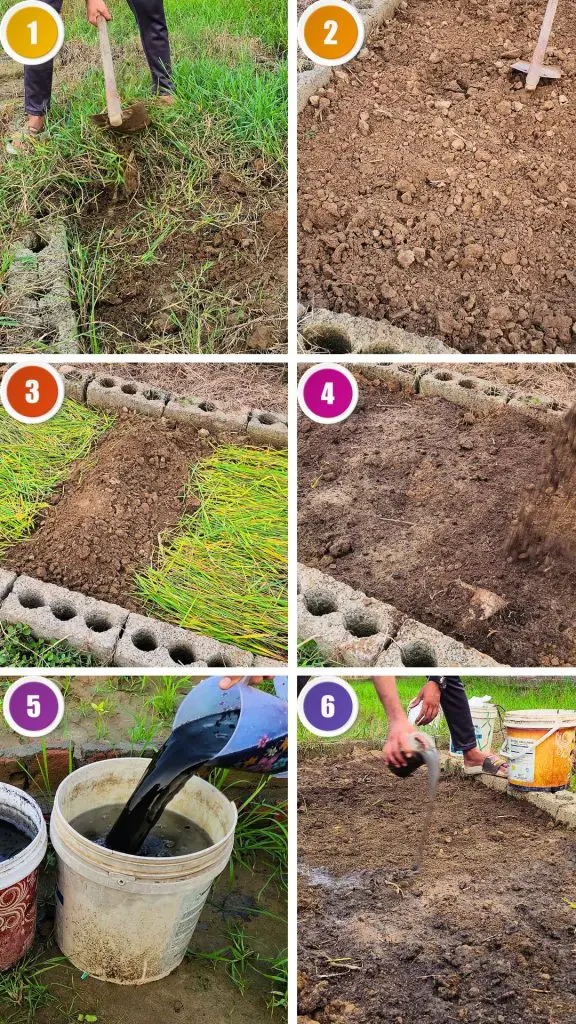Rebuilding a garden bed after the soil has lost its fertility can seem like a huge task, but with the right approach, it can be one of the most rewarding things you’ll ever do for your garden. Healthy soil is the foundation of every successful garden, and when we rebuild it layer by layer using natural, organic materials, we bring life back to the ground beneath our plants.
This method creates a self-sustaining ecosystem in your bed where nutrients cycle naturally, and plants thrive without needing chemical fertilizers.

Clearing and Preparing the Garden Bed
The first step in rebuilding your garden bed is to clear it completely. Remove all weeds, old plant roots, and any leftover debris. But remember — the weeds you pull out are not useless. They are packed with nutrients that can be reused in the garden. Instead of throwing them away, dry them and use them as mulch, or save them to make liquid fertilizer.
Weeds are nature’s free fertilizer source; they collect minerals from deep in the soil, and when decomposed, they return those minerals to the surface for your plants to use.
Once the weeds are cleared, grab a shovel, hoe, or garden fork and start breaking up the soil. This step is very important because compacted soil stops air and water from reaching plant roots.
Breaking up large chunks of soil helps create tiny air pockets, improves drainage, and makes it easier for roots to spread out. Loosen the soil about six to eight inches deep and then level it evenly with your shovel. The surface should be flat so that water can spread uniformly when you irrigate or during rainfall.
The Importance of Building Soil in Layers
Instead of dumping everything in one go, the secret to a healthy garden bed lies in building it layer by layer. Each layer serves a purpose — feeding the soil, improving structure, retaining moisture, and encouraging microbial life.
Over time, these layers blend together, forming a rich, fertile foundation for your plants. Think of it like making a compost lasagna — each layer adds something different but equally essential.
Adding the Cover Crop Layer
The first organic layer we add is made of cover crops or green plant material. You can use chopped leaves, grass clippings, or any green matter available in your garden. Spread the material evenly over the entire bed. Cover crops are an incredible source of natural organic matter. When they decompose, they release nitrogen — one of the most vital nutrients for plant growth.
Beyond just feeding the soil, cover crops also improve its structure. They make the soil lighter and more porous, which allows oxygen to flow freely. They encourage earthworms and beneficial microbes to thrive, which in turn helps with decomposition and nutrient cycling. Cover crops also increase the soil’s ability to retain moisture, preventing it from drying out too quickly during hot days.
Adding a thick layer of cover crop material is like giving your soil a natural energy boost. As it breaks down, it forms humus — a soft, dark, sponge-like layer that becomes the heart of fertile soil.
The Loamy Soil Layer
Once the cover crop layer is in place, it’s time to add a layer of loamy garden soil. Loam is often considered the perfect soil type for growing plants because it’s a balanced mix of sand, silt, and clay. It holds water well without becoming soggy, and it allows excess moisture to drain easily.
When you spread the loamy soil on top of the cover crop layer, it helps create a natural blending zone. The organic material beneath begins to decompose and mix with the loam above, slowly releasing nutrients upward into the new soil layer. This also encourages microorganisms to spread throughout the bed, linking the layers together.
Loamy soil also provides excellent root support. It’s soft enough for roots to grow freely, but firm enough to anchor plants securely. Its nutrient-holding capacity is another reason why it’s ideal for this step — it absorbs and stores nutrients that are slowly released as plants grow.
The Manure Layer
After the loamy soil comes one of the most important layers — fully decomposed manure. This is nature’s slow-release fertilizer, rich in essential nutrients like nitrogen, phosphorus, and potassium. But manure does much more than feed plants; it also improves the texture and long-term health of the soil.
When manure breaks down, it increases the soil’s capacity to hold moisture. This means you’ll need to water your plants less frequently, and during dry spells, the soil will stay moist for longer. Manure also helps prevent soil compaction, keeping it soft and easy to work with.
Another major benefit of manure is that it boosts the population of beneficial microorganisms. These tiny living organisms help break down organic matter into nutrients that plants can easily absorb. Over time, manure transforms even poor soil into dark, rich, living earth.
It’s crucial, however, to ensure that the manure you use is fully decomposed. Fresh manure can burn plant roots and introduce unwanted weed seeds. Well-rotted manure, on the other hand, has a pleasant earthy smell and a crumbly texture — that’s what you want for your garden bed.
The Special Mixture Layer: Weeds, Charcoal, and Compost
The final and most powerful layer in this rebuilding method is a special mixture made from weeds, crushed charcoal, and compost. This combination might sound unusual, but it’s one of the most balanced organic blends you can use.
Each ingredient plays a special role.
- Weeds are a rich source of micronutrients and natural plant enzymes. When decomposed, they release valuable nutrients back into the soil, helping future plants grow stronger and more resilient.
- Crushed charcoal (also known as biochar) is a natural soil enhancer. It traps nutrients and prevents them from washing away during rain or watering. It also keeps harmful bacteria at bay and provides a home for beneficial microbes to live in. Charcoal improves the structure of the soil, keeping it light and aerated while maintaining excellent moisture balance.
- Compost is the final element that brings everything together. It is full of beneficial microorganisms that help decompose organic matter. Compost also improves the soil’s ability to hold water and gives it a dark, rich color that every gardener loves to see.
When these three ingredients are mixed and spread evenly on top of the bed, they form a nutrient-dense, protective layer that continues to feed the soil for months. It also acts as a shield against weeds and erosion, while improving the overall quality of the soil below.
How the Layers Work Together
As time passes, all these layers begin to blend naturally. The cover crop at the bottom starts to decompose first, releasing nutrients that move upward into the loamy soil. The manure provides a steady nutrient supply for the growing plants, while the special mixture on top maintains soil structure and microbial balance.
This process mimics the natural way forests build soil — by layering organic matter year after year. The result is a garden bed full of life, with billions of beneficial bacteria, fungi, and earthworms working together to keep the soil fertile and balanced.
